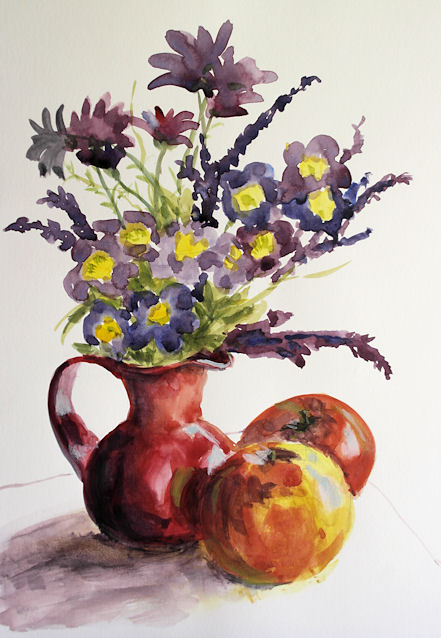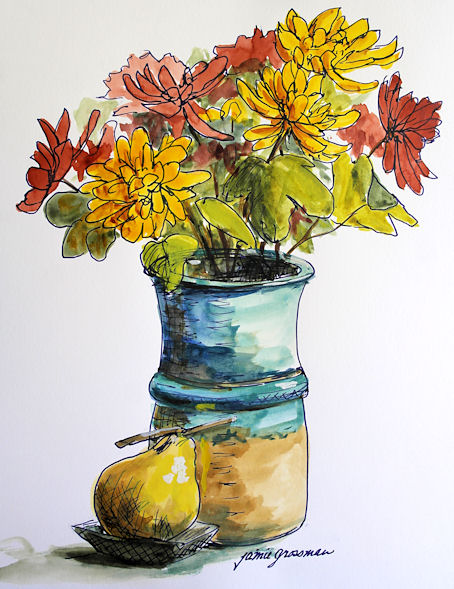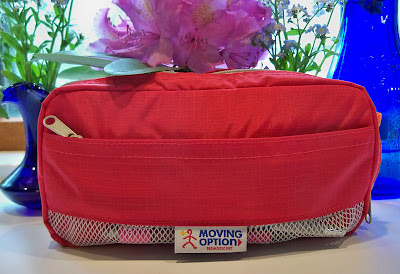This classy-looking pouch is the
Lihit Lab Teffa Pen Case. I've filled it with watercolor supplies to serve as a medium size watercolor sketch kit.
Most of you have probably seen my
recent review of the Nomadic PE-07 Pencil Pouch, which I use as a very lightweight sketch/watercolor kit. That one lives in my pocketbook and I do love it. It's perfect for those unexpected sketch opportunities that come along while waiting for someone or something.
But I do miss my real brushes, as well as my slightly larger palette for those real brushes. I wanted an additional kit to take hiking and plein air painting, that can work with my custom Arches Rough sketchbook, as well as with the larger 8.5x11" Stillman & Birn books. Those books require the ability to lay down more paint with larger brushes, at least half-pan size paint reservoirs, and larger mixing areas. I ordered this Lihit Lab case to serve that purpose.
As you can see, the front of the case does a great job of holding my brushes, pencils and pens. I considered putting a small piece of Velcro in the center of the upper strip to hold the brushes in place better. The Velcro would give the brushes more security, but would take up space and reduce the number I could fit in there. I decided to try it the way it is first, and it worked just fine.
The brushes were a bit too long and needed help to fit in there. I measured how long they could be, cut them down with a hacksaw, and sharpened the ends with a pencil sharpener so they could be used to scratch out twigs, branches, etc. Then I dipped the sharpened ends in Golden GAC100 to seal the wood. I used old sables and synthetics, since I didn't want to butcher any fabulous brushes that also might get lost out in the field while hiking.
On the left in the above image, you can see my latest favorite pencil lead holders. I've always loved 2mm leads, but the ordeal with trying to keep them sharpened made them difficult to use when convenience is a factor. Well, have I got great news for you! These lead holders come with a sharpener in the end. Yep, problem solved!
They are only $3.30 each (and come with a lead) at Jetpens.
I have 2mm leads in many grades of hard/soft, so I made up some labels on a label-maker, and put a different lead into each of the four that I got. Here's a closeup shot of the top of the pencils so you can see where the sharpener is:
Turning over the center divider, you can see how I organized the back of this kit:
My palette and a Mini Mister slide right into the pocket together at the back of the case, and there's room above them for double clip-on oil painting palette cups to hold my water. By keeping one water cup for warm colors and one for cool, I can get by with very little water. As hikers know, water is both precious and heavy to carry! Opposite those are small web pocktes that I use for holding a mini scrubber (from the pharmacy, for brushing gums/teeth), a little vial of Pro White (in place of white tubed gouache), a kneaded eraser, and a metal binder clip.
The palette has velcro on the back of it, and gets affixed to a 9x12 piece of Coroplast (a very lightweight, corrugated plastic), which I've prepared with the other side of the velcro. The palette cups clip onto the bottom of the board, like this:
The empty side of the board then slides into the sketchbook to help keep it secure. You could use rubber bands around the board and page for additional security if you wish or use a large metal binder clip. I can sit very comfortably with everything on my lap this way, and have both hands free.
This little, light setup enables me to paint 11x17 without even having to cart an easel around with me! I put a weightless closed cell foam gardening cushion in my backpack and I can sit almost anywhere in comfort.
So, how did this work out in practice? It worked great! I've taken it out three or four times now, and have come away with a few conclusions:
- The Lihit Pen Case is the perfect size for this kit. If it were any bigger, I'd be cramming it with more stuff that would be heavy and unnecessary for watercolor sketching. It fits the palette and exactly what I need to go with the palette. No more, no less.
- I desperately need a squirrel mop brush for this kit, since this setup enables me to go large enough to make use of it. I'll have to buy one or two inexpensive ones to cut down because I am NOT butchering my Rekabs!
- About half of the brushes I do have in here I won't need. I'm going to whittle down the assortment before I go out again.
- Keeping the kneaded eraser in a plastic case is a pain in the neck and wastes time. I'm going to remove it from the case and stick it in with the brushes.








.JPG)
.JPG)
.JPG)
.JPG)































